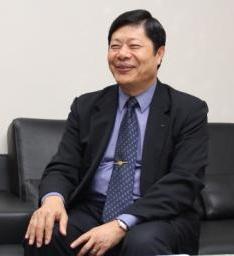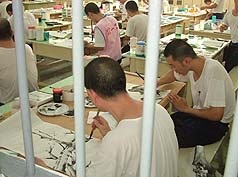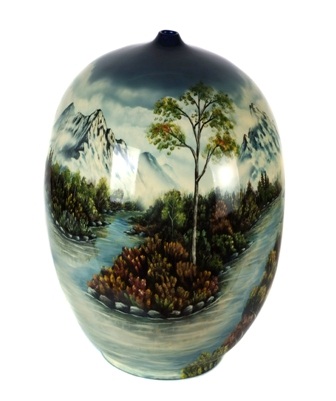Promoting Taiwan crafts made behind bars
- 發布日期:
- 最後更新日期:107-10-31
- 資料點閱次數:3450
Promoting Taiwan crafts made behind bars
 |
“Ethnic Chinese believe that man is born kind, and I’m fully convinced that even the toughest members of society can be reformed, if the methods are right,” AOC Director-General Wu Sen-chang said.
As the highest official in Taiwan’s prison system, Wu is always looking for ways to open inmates’ minds and unlock the doors to hope. “This is what the two keys of the agency’s logo represent and the core value of our work here.”
|
| AOC Director-General Wu Sen-chang is a strong advocate of art education in Taiwan’s correctional institutions. (Photos courtesy of AOC) | An avid calligrapher himself, Wu believes the rich cultural inheritance of Taiwan’s traditional arts and crafts can have a particularly enlightening effect on convicts. “We like to say that art is about truth, goodness and beauty. I have no doubt that art can re-educate prisoners in imperceptible ways, far more effectively than formal disciplinary measures.” |
According to Wu, the idea to introduce art programs to prisons came from a visit to a correctional institution in Nagano, Japan, when he was going to graduate school in Tokyo in the mid-1980s.
“I was surprised to find that the facility had been turned into a gallery filled with artworks by prisoners. I’ll never forget the expressions of concentration on the faces of the inmates at work.” He initiated a pilot art project at Tainan Prison in 1993, and now similar programs are available at every correctional facility in Taiwan.
These sessions help inmates learn to focus their attention and develop perseverance, and the painstaking effort it takes to master a skill also facilitates reflection on the past. “It is very important that they understand the importance of dedication and determination, because these qualities will help them face challenges and frustration when they return to society,” he said.
Unselfish contributions from craft masters are a deciding factor in the programs’ success, according to Wu. “When we first approached these instructors, they were almost all appalled by the idea of working with criminals.” But they came around after watching inmates interact with their teachers in class, he said. “Most of them eventually became fervent and long-time participants in our projects.”
 |
For these instructors, teaching
AOC art classes is more than
volunteer work—it is also a great way to preserve and revive
traditional arts and crafts. “For years, masters of many traditional
folk arts have been complaining about not being able to find
apprentices to pass their skills on to,” said Wen Xian-liang, a teacher
of lantern-making. “The AOC’s measure is a creative solution to this
predicament.” Chen Hong-teng, a master in the craft of making oil-paper umbrellas, maintains that as long as prisoners want to learn something, they are good students. “My students have never complained or quit when they encountered difficulties. Every umbrella they make is unique and represents their resolution to right past wrongs. I am very proud of them.” An inmate serving time in Kaohsiung Prison said, “The teacher says a paper umbrella symbolizes perfect happiness. Although they’re no longer used as protection against rain, people still like to buy them as gifts for friends. |
| Chinese painting classes help inmates serving time in Penghu Prison settle their minds. (CNA) | “I like to think that the umbrellas I make can bring people good luck. This gives me the confidence that I can also move on with my life in a positive way.” |
A convict in Hualien, the eastern county renowned for its abundant supply of marble, views his participation as a vital step in the search for redemption. “We are grateful to our superiors for encouraging us to make stone carvings and planning an exhibition room to display our work. This has allowed people to appreciate our creativity and more importantly, our fierce determination to go straight.”
According to Wu, the art programs and similar courses also make prison management a lot easier. While 44 percent of convicts in Taiwan are drug abusers, who are usually not violent offenders, they tend to be agitated in the early stages of incarceration. “Allowing them to take part in art classes can help them find peace of mind, adapt to imprisonment and hopefully get back on track,” he added. This is evidenced by the high staff to inmate ratio of 1-to-14 in Taiwan, compared with 1-to-4 in Japan and South Korea, he added.
Other than keeping convicts busy so that they will not cause trouble, another important purpose of the programs is to provide training that will help prisoners land a job when they have done their time, so they will not end up in prison again out of desperation, Wu said.
 |
The AOC makes inmates’ artworks,
along with food products and other
items they produce, available to the general public as a form of
connection with the outside world. At first the goods were sold at
visitor centers in correctional institutions and charity fairs around
the country. “Word-of-mouth referrals began generating huge business for us,” Wu noted. “We had not expected such a great response.” Sales of all prisoner-made products amounted to NT$409.75 million (US$13.86 million) in 2012, up 27.57 percent from the year before. Demand for such goods was so huge that the MOJ had to set up an online store to handle orders. “But we don’t want to give the impression that we are running a business operation,” Wu said. That is why products created by offenders are not sold through high-profile marketing campaigns, but only through the ministry’s website and facilities. “In the beginning, over 70 percent of our clients were government agencies. But the products have become so popular that some items are often back-ordered over more than a month,” Wu said. The next major project is a joint performance scheduled for August in Taipei for inmates with exceptional achievements in their respective fields of training. “It really takes tremendous courage for men and women behind bars to go on stage,” Wu remarked. “I think this will be a great chance to prove that they can be rehabilitated. Support from the general public is very important, as is support from inmates’ families.” In his 40 years of public service, Wu has accompanied 24 death row inmates to their executions. “I’ll never forget the remorse these men displayed at the last moment. I really hope what we are doing can help prevent criminals from taking the road to perdition. I will never give up on that mission, even if I can save only one prisoner at a time.” (THN) Over the years Wu has witnessed great transformations in some inmates. “You can tell from their eyes that they’d changed, that they truly felt the sincerity of the craft masters,” he said. The sense of achievement and experience of success they get from mastering something that was previously totally unfamiliar to them is a source of inspiration after they walk out of the penitentiary,” he added. |
| Lacquerware created by convicts at Taichung Prison is one of the facility’s most popular products. |
Write to Meg Chang at sfchang@mofa.gov.tw

